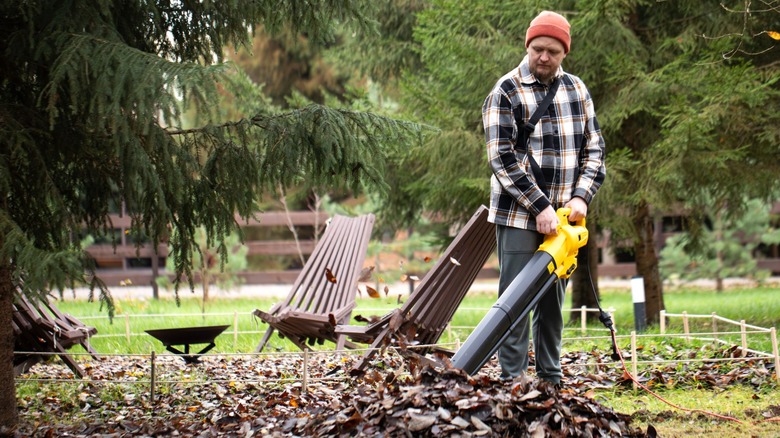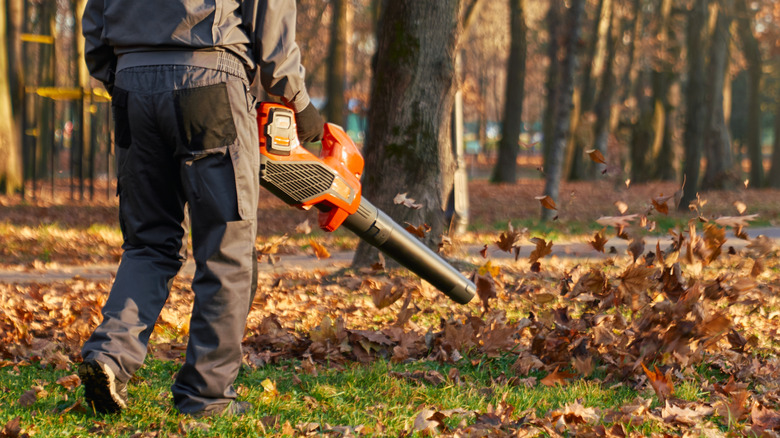Handheld Vs Backpack Leaf Blower: How To Choose The Right One For Your Needs
When you're looking for a way to quickly take care of autumn's carpet of leaves that's covering your yard, you might choose to focus on the most reliable leaf blower models and brands. However, taking a step back, you must first make a choice in terms of the format of the machine — a handheld or backpack style. The key factors that can help you choose between a backpack or handheld leaf blower are the size of your yard, your physical strength, the level of noise you're comfortable with, and the power you need to clear the debris that builds up around your property. If you have a large yard and you frequently need to remove wet leaves, the backpack-style machine may be the way to go, even though it's generally louder. For those who have smaller yards and less debris, the smaller handheld model is a common choice. It's lighter and easier to maneuver, which could be a necessity for many homeowners tackling the project alone.
However, there are some further advantages and disadvantages that might sway you toward the handheld blower over the backpack design or vice versa. Before discussing additional differences between these two designs, it's important to note they have some similarities. Both designs are available in gas, corded electric, or battery-powered machines, letting you choose the best option based on your top criteria. Many manufacturers offer both backpack and handheld designs, including Stihl, Troy-Bilt, and Husqvarna, meaning you can stick with your favorite brand no matter the style. Sure, you could try to clear away leaves without a leaf blower, but these outdoor power tools make the job go significantly faster while requiring less physical effort than raking.
Benefits of a backpack-style leaf blower
A backpack leaf blower contains the motor and fuel source in a machine attached to padded straps you can wear over the shoulders like a school backpack. This design distributes the weight of the blower across the shoulders and back, allowing it to be larger while limiting muscle strain. It's designed for use during longer leaf-blowing sessions. You attach the blower tube to the machine and carry the tube in your hand. Many units have a throttle on the tube or near your hip, allowing you to control the power level without having to take the backpack off.
A typical backpack blower generates 400 to 700 cubic feet per minute (CFM) of air movement, while a commercial-level unit could even exceed 1,100 CFM. Handheld models may create 200 to 400 CFM. Higher CFM ratings allow you to move more debris compared to lower-power devices, as well as damp leaves that are heavier. If you're using a battery-powered backpack model, you'll probably need at least a large 60V battery, although some units run from two batteries. If you use a gas-powered backpack leaf blower, it will have a large gas tank, allowing you to work longer without having to refuel. A common fuel tank size is around 1.8 liters for the backpack design, while a handheld leaf blower might only have a 0.5-liter tank. Generally, if you have a large property with significant debris to move, a backpack blower will make the job quicker and require fewer breaks to refill the batteries or gas tank.
Deciding if handheld leaf blowers are right for you
A handheld leaf blower's design has the motor and handle together with the blower tube extending from the motor. You'll hold the machine by the handle near the motor to support the heaviest part of this outdoor power tool. Some models have a second handle above the blower tube to provide extra control and support. These models often have a variable speed setting option, allowing you to adjust how much power the machine generates. For most people, the handheld unit's lighter weight (compared to the backpack design) is its primary advantage. However, understand that you will often be supporting the entire tool's weight with one arm during operation, which can lead to muscle fatigue.
Because it uses a smaller motor and moves less air (measured by CFM), the handheld design generates less noise than the bigger backpack model's motor. If you live in an area where noise regulations exist, you might only be able to use a handheld design, an important consideration when you want to avoid any issues with your neighbors or the law while leaf blowing. A handheld leaf blower tends to have a lower price than a backpack leaf blower design, too. If you only expect to use this tool occasionally, you might want to stick with the smaller design to save some money. The smaller handheld design is an advantage when you're working in tight spaces, such as removing debris from a flower bed or directing grass clippings off your patio or sidewalk. If you have gravel or mulch in your flower bed, the more powerful backpack model could dislodge these items.


